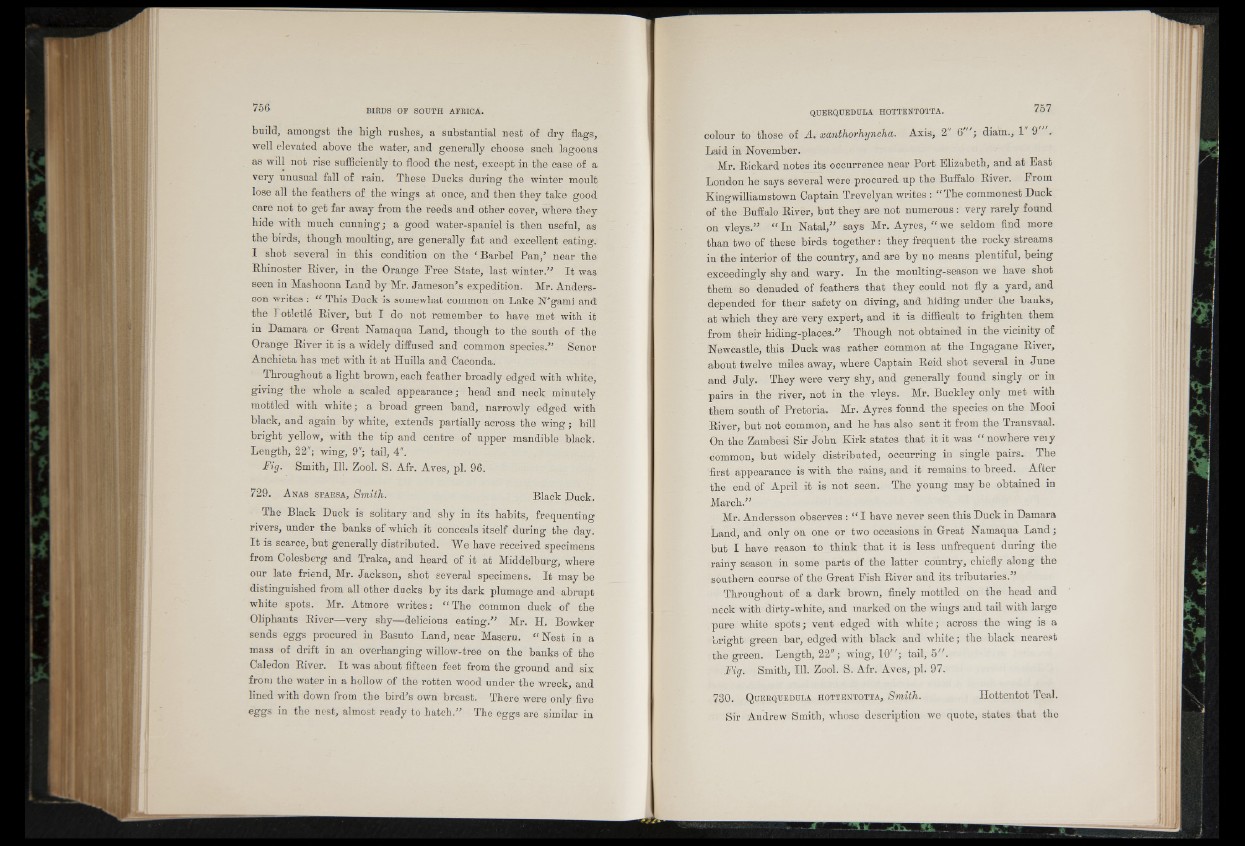
build, amongst the high rushes, a substantial nest of dry flags,
well elevated above the water, and generally choose such lagoons
as will not rise sufflciently to flood the nest, except in the case of a
very unusual fall of rain. These Ducks during the winter moult
lose all the feathers of the wings at once, and then they take good
care not to get far away from the reeds and other cover, where they
hide with much cunning; a good water-spaniel is then useful, as
the birds, though moulting, are generally fat and excellent eating.
I shot several in this condition on the ‘Barbel Pan,5 near the
Rhinoster River, in the Orange Free State, last winter.55 It was
seen in Mashoona Land by Mr. Jameson5s expedition. Mr. Anders-
son writes : “ This Duck is somewhat common on Lake N5garni and
the 1 otletle River, but I do not remember to have met with it
in Damara or Great Namaqua Land, though to the south of the
Orange River it is a widely diffused and common species.55 Senor
Anchieta has met with it at Huilla and Caconda.
Throughout a light brown, each feather broadly edged with white,
giving the whole a scaled appearance; head and neck minutely
mottled with white; a broad green band, narrowly edged with
black, and again by white, extends partially across the wing; bill
bright yellow, with the tip and centre of upper mandible black.
Length, 22"; wing, 9"; tail, 4".
Fig. Smith, 111. Zool. S. Air. Aves, pi. 96.
729. A nas sparsa, Smith. Black Duck.
The Black Duck is solitary and shy in its habits, frequenting
rivers, under the banks of which it conceals itself during the day.
It is scarce, but generally distributed. We have received specimens
from Colesberg and Traka, and heard of it at Middelburg, where
our late friend, Mr. Jackson, shot several specimens. It may be
distinguished from all other ducks by its dark plumage and abrupt
white spots. Mr. Atmore writes: “ The common duck of the
Oliphants River—very shy—delicious eating.55 Mr. H. Bowker
sends eggs procured in Basuto Land, near Maseru. “ Nest in a
mass of drift in an overhanging willow-tree on the banks of the
Caledon River. It was about fifteen feet from the ground and six
from the water in a hollow of the rotten wood under the wreck, and
lined with down from the bird5s own breast. There were only five
eggs in the nest, almost ready to hatch.55 The eggs are similar in
colour to those of A. xanthorhyncha. Axis, 2" 6"'; diam., 1 '9 .
Laid in November.
Mr. Rickard notes its occurrence near Port Elizabeth, and at East
London he says several were procured up the Buffalo River. From
Kingwifliamstown Captain Trevelyan writes : “ The commonest Duck
of the Buffalo River, but they are not numerous: very rarely found
on vleys.55 “ In Natal,55 says Mr. Ayres, “ we seldom find more
ttian two of these birds together: they frequent the rocky streams
in the interior of the country, and are by no means plentiful, being
exceedingly shy and wary. In the moulting-season we have shot
them so denuded of feathers that they could not fly a yard, and
depended for their safety on diving, and hiding under the banks,
at which they are very expert, and it is difficult to frighten them
from their hiding-places.55 Though not obtained in the vicinity of
Newcastle, this Duck was rather common at the Ingagane River,
about twelve miles away, where Captain Reid shot several in June
and July. They were very shy, and generally found singly or in
pairs in the river, not in the vleys. Mr. Buckley only met with
them south of Pretoria. Mr. Ayres found the species on the Mooi
River, but not common, and he has also sent it from the Transvaal.
On the Zambesi Sir John Kirk states that it it was “ nowhere veiy
common, but widely distributed, occurring in single pairs. The
first appearance is with the rains, and it remains to breed. After
the end of April it is not seen. The young may be obtained in
March.55
Mr. Andersson observes : “ I have never seen this Duck in Damara
Land, and only on one or two occasions in Great Namaqua Land;
but I have reason to think that it is less unfrequent during the
rainy season in some parts of the latter country, chiefly along the
southern course of the Great Fish River and its tributaries.55
Throughout of a dark brown, finely mottled on the head and
neck with dirty-white, and marked on the wings and tail with large
pure white spots; vent edged with white; across the wing is a
bright green bar, edged with black and white; the black nearest
the green. Length, 22"; wing, 10"; tail, 5".
Fig. Smith, 111. Zool. S. Afr. Aves, pi. 97.
730. Q uerquedula h ot tentotta, Smith. Hottentot Teal.
Sir Andrew Smith, whose description we quote, states that the